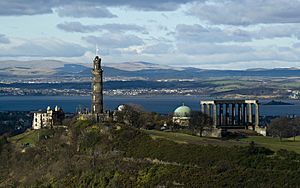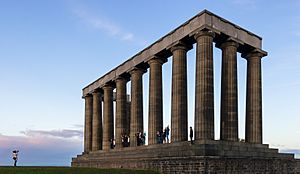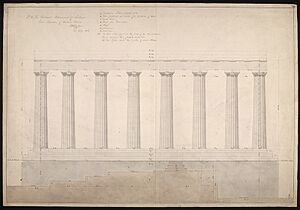National Monument of Scotland facts for kids

The National Monument of Scotland is a special memorial in Edinburgh, Scotland. It stands tall on Calton Hill, a famous spot in the city. This monument was built to remember the brave Scottish soldiers and sailors who lost their lives fighting in the Napoleonic Wars. Its purpose was to be "A Memorial of the Past and Incentive to the Future Heroism of the Men of Scotland." This means it looks back at past bravery and encourages future heroes.
The monument is a big landmark on Calton Hill, close to Princes Street. It was designed between 1823 and 1826 by Charles Robert Cockerell and William Henry Playfair. They based its design on the ancient Parthenon temple in Athens, Greece. Building started in 1826, but it stopped in 1829 because there wasn't enough money. Because it was never finished, people gave it nicknames like "Scotland's Folly" or "Edinburgh's Disgrace."
Contents
Ideas for the Monument
As early as 1816, a group called the Highland Society of Scotland wanted to build a national monument. They wanted to honor those who died in the Napoleonic Wars. At first, they thought about building it on The Mound, but they chose Calton Hill instead.
In January 1822, a plan was made to build a copy of the Parthenon. This was estimated to cost about £42,000. Many important people in Edinburgh supported this idea. These included famous writer Sir Walter Scott and judges Henry, Lord Cockburn and Francis, Lord Jeffrey. A key person who pushed for the Parthenon design was Thomas Bruce, 7th Earl of Elgin.
In July 1822, a group called the Royal Association of Contributors to the National Monument of Scotland was officially formed by an Act of Parliament. The first stone was laid with a big ceremony the next month.
Sixteen months after the fundraising started, only £16,000 had been collected. There was also a chance of getting £10,000 from Parliament. In 1826, the building work finally began. The company chosen to build it was Messrs William Wallace & Son.
Originally, the monument was planned to have large underground areas. These were meant to be burial places for important Scottish figures. The Royal Association said in 1826 that the building would be like the Parthenon. They wanted it to celebrate the achievements of Scottish heroes. Part of the building was also meant to be a church.
Laying the First Stone
The first stone of the monument was very heavy, weighing 6 tons. It was laid on August 27, 1822. This happened during a special visit by King George IV to Scotland.
The Duke of Hamilton led a large parade. This parade included masonic lodge members, royal officials, and other important people. They walked from Parliament Square to the top of Calton Hill. Soldiers from the Scots Greys and the 3rd Dragoons escorted the procession.
When the special plates were placed in the stone, cannons fired salutes. These cannon shots came from Edinburgh Castle, Salisbury Crags, Leith Fort, and the royal ships in Leith Roads.
Ideas for Finishing the Monument
Over the years, many ideas have been suggested to finish the National Monument. Early plans wanted to follow the original design. However, in the early 1900s, new ideas came up:
- It was suggested as a monument to Queen Victoria in 1901.
- In 1907, it was proposed as a memorial for the 1707 Act of Union with England.
- Also in 1907, there was an idea to make it a new Scottish National Gallery.
- In 1908, some thought it could become a Scottish Parliament building.
- After World War I, in 1918, it was suggested as a memorial for those who died in the Great War.
Later attempts to finish the monument have never worked out. This was usually because of high costs or a lack of local interest. A plan in 2004 also received mixed reactions.
The monument was repaired in December 2008. One of the stone beams had moved out of place and was fixed. This repair cost over £100,000.
Protection
The National Monument was given a special protection status in 1966. It is now a Category A Listed building. This means it is a building of great historical importance.
See also
 In Spanish: Monumento nacional de Escocia para niños
In Spanish: Monumento nacional de Escocia para niños




